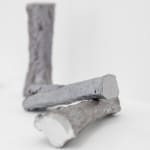Sophronia Cook and Rindon Johnson
Organized Science, 2024
Aluminum
4 parts, each 12 cm | 4 3/4 inches
Copyright The Artist
Weitere Abbildungen
-
(View a larger image of thumbnail 1
)

-
(View a larger image of thumbnail 2
)

-
(View a larger image of thumbnail 3
)

-
(View a larger image of thumbnail 4
)

-
(View a larger image of thumbnail 5
)

-
(View a larger image of thumbnail 6
)

-
(View a larger image of thumbnail 7
)

-
(View a larger image of thumbnail 8
)

„Organized Science“ (2024) ist eine kollaborative Arbeit von Rindon Johnson und Sophronia Cook, in der sie das Knochenmark von Rindern in Aluminium gießen. Die vierteilige Skulptur ist eine Transformation von...
„Organized Science“ (2024) ist eine kollaborative Arbeit von Rindon Johnson und Sophronia Cook, in der sie das Knochenmark von Rindern in Aluminium gießen. Die vierteilige Skulptur ist eine Transformation von organischem in festes Material und untersucht die Grenze zwischen Lebendigkeit, natürlichem Zerfall und künstlicher Konservierung. Die Aluminiumformen sind eine Übersetzung von Körperlichkeit in skulpturale Fragmente und öffnen einen Dialog über die Verbindung und Abgrenzung zwischen menschlicher und tierischer Existenz. Sophronia Cook und Rindon Johnson arbeiten in ihrer Kollaboration auf eine Weise zusammen, die ihre individuellen künstlerischen Herangehensweisen verbindet. Während Johnson oft die natürliche Veränderung seiner Materialien betont, indem er sie Witterung und Zeit aussetzt, findet Cook in der Materialtransformation eine Ausdrucksform für ihre eigene Auseinandersetzung mit Form und Textur. Die Zusammenarbeit verbindet ihre künstlerischen Philosophien zu einer gemeinsamen Sprache: Die Aluminiumabgüsse der Rinderknochen werden so zu einem Werk, das die Fragilität und zugleich die Kraft des Lebendigen und des Vergangenen erfahrbar macht. In „Organized Science“ wird die Flüchtigkeit des Organischen zur Basis für eine Betrachtung über das Bleibende und so zu einer Art Erinnerungsspeicher.
"Organized Science" (2024) is a collaborative work by Rindon Johnson and Sophronia Cook, in which they cast the bone marrow of cattle in aluminum. This four-part sculpture transforms organic material into solid form, exploring the boundary between vitality, natural decay, and artificial preservation. The aluminum forms translate corporeality into sculptural fragments, opening a dialogue about the connection and separation between human and animal existence. In this collaboration, Sophronia Cook and Rindon Johnson merge their individual artistic approaches. While Johnson often emphasizes the natural transformation of his materials by exposing them to weather and time, Cook finds expression in material transformation as a means to explore form and texture. This collaboration fuses their artistic philosophies into a shared language: the aluminum casts of cattle bones become a work that makes the fragility and strength of both the living and the past tangible. In "Organized Science", the ephemerality of the organic becomes a foundation for contemplating permanence, thus acting as a form of memory storage.
"Organized Science" (2024) is a collaborative work by Rindon Johnson and Sophronia Cook, in which they cast the bone marrow of cattle in aluminum. This four-part sculpture transforms organic material into solid form, exploring the boundary between vitality, natural decay, and artificial preservation. The aluminum forms translate corporeality into sculptural fragments, opening a dialogue about the connection and separation between human and animal existence. In this collaboration, Sophronia Cook and Rindon Johnson merge their individual artistic approaches. While Johnson often emphasizes the natural transformation of his materials by exposing them to weather and time, Cook finds expression in material transformation as a means to explore form and texture. This collaboration fuses their artistic philosophies into a shared language: the aluminum casts of cattle bones become a work that makes the fragility and strength of both the living and the past tangible. In "Organized Science", the ephemerality of the organic becomes a foundation for contemplating permanence, thus acting as a form of memory storage.







